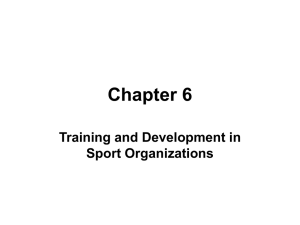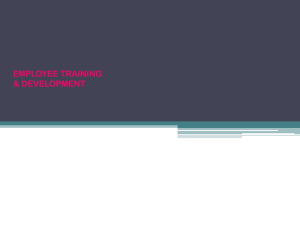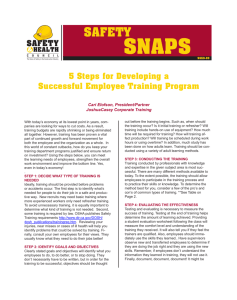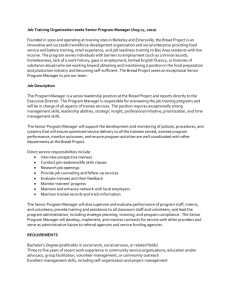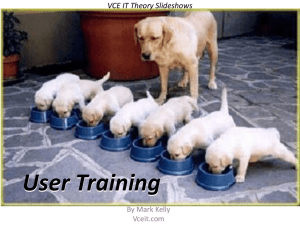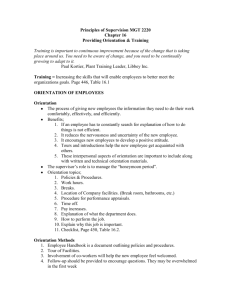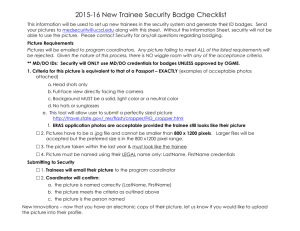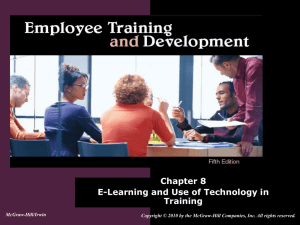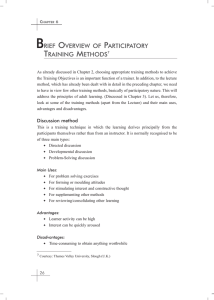Methods of training managed by senior members
advertisement
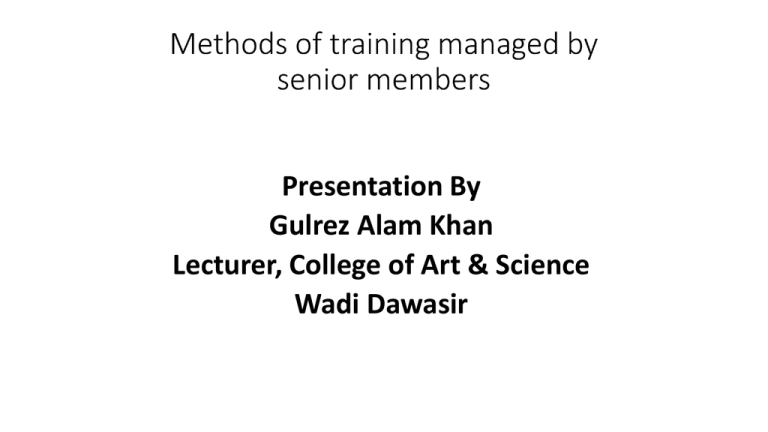
Presentation By
Gulrez Alam Khan
Lecturer, College of Art & Science
Wadi Dawasir
TRAINING
In simple words it can be defined as
equipping employees with required
knowledge and skills for the job.
WHY TRAINING?
• Dynamic Business Environment
• Technological Advances
Advantages of Training
• Increased Productivity
• Reduced Accidents
• Reduced Supervision
• Heightened Morale
TYPES OF TRAINING
• On the job training
• Off the job training
On the Job Training
It refers to new or inexperienced employees learning
through observing peers or managers performing the
job and trying to imitate their behavior.
Methods of on the Job Training
• COACHING
• MENTORING
• JOB ROTATION
• JOB INSTRUCTION TECHNIQUE
COACHING
• It is one to one interaction
• Considered as corrective measure for inadequate performance.
• Helps in identifying weaknesses and focuses on areas which needs improvement.
MENTORING
• Mentoring focus on attitude development.
• Conducted for management-level employees
• Mentoring is done by someone inside the company
It is one-to-one interaction
• It helps in identifying weaknesses and focus on the area that
needs improvement
Advantages of “On-the –job” Methods
• Generally more cost effective
• Less disruptive to the business - i.e. employees are not away from
work
• Training with equipment they are familiar with and people they know
can help them
• Gain direct experience to a standard approved by the employer
• On the job training is also productive, as the employee is still working
as they are learning
Off-the-Job Training Method
• Trainee is separated from the job environment
• Take place at training agency or local college, training centres
• Study materials
• Fully concentrate on learning rather than
performing
• Freedom of expression
Types of Off the Job methods
• Vestibule Training
• Management Games
• Role Playing
• Films
• Lecture Methods
• Outbound Training
Vestibule Training
• Actual work conditions are simulated
• Materials, files and equipments are used
• Duration ranges from few days to a few weeks
• Theory can be related to practice here
Advantages
•
•
•
•
Training becomes more reality-based.
Directly applies to jobs.
Increases the chances of retention.
Prevents trainees from making costly mistakes or damaging
equipment.
• Allows instructors to give more personalized attention to the learners.
Disadvantages
•
•
•
•
Time Consuming
Expensive
Trainer has to be very skilled
There has to be elaborate setups for the same
Management Games
• To improve decision making and analytical skills.
• To develop awareness of the need to make decisions lacking complete
information.
• To develop an understanding of the interrelationships
• To develop the ability to function cooperatively and effectively in a
small group situation.
Types of management Games
• Executive Games are general management games and cover all functional areas {like planning,
decision making, etc} of business and their interactions and dynamics. Executive games are designed
to train general executives.
• Functional Games, on the other hand, focus on middle management decisions and emphasize
particular functional areas {like Marketing or HR} of the firm.
ROLE PLAYING
Is the method of human interaction that involves realistic
behavior in imaginary situations.
Benefits of Role playing
• Developing interpersonal skills and communication skills
• Conflict resolution
• Group decision making
• Developing insight into one’s own behavior and its impact on others
Types of Role play
• Multiple role play
• Single role play
• Role rotation
• Spontaneous role play
Films/Video Presentations
• Content for the training experience comes primarily from a
videotape or computer-based program.
• Interest of the audience can be maintained by showing them audio
visuals
• Easy to handle and explain
• Provides a lot of content to talk about
Advantages & Disadvantages
Advantages –
•
Easy to train and the trainer can follow up with questions and discussions
•
Assured to provide same information to all the trainees
Disadvantages–
•
Expensive to develop
•
Such type of training has to be outsourced which may make the training less content specific.
Outbound Training
• Outdoor and action-oriented programs through experiential learning
• Develops Leadership, teamwork and risk-taking abilities
• Interesting as compared to classroom leaning
• Conducted by professionals who are very cooperative
Advantages
• Trainees can immediately see the consequences of wrong actions
• Materialistically enhance their thinking and behavior
Disadvantages
• Work time has to be allotted for it.
• Interest of the participants is required.
Lecture Method
• Lecture is traditional & direct method of instruction.
• It is a verbal presentation of information by an instructor to a
large audience.
• The lecture must motivate & create interest among the trainees
in order to become effective
• It is presumed to posses a considerable depth of knowledge of
subject at hand.
• This method is used mainly in college and universities
Advantages
• Less time required for preparation
• Provides lots of information quickly
• Cost per trainee is very low
Disadvantages
• Does not involve trainees too much.
• Trainees may forget the teaching as it is presented only orally.
Few Other Methods
In-Basket Exercise
• Also known as In-tray method of training.
• The trainee is presented with a pack of papers & files in a tray
containing administrative problems & is asked to take decisions on
these problems & are asked to take decisions on these within a
stipulated time.
• The decisions taken by the trainees are compared with one another.
The trainees are provided feedback on their performance.
Cont….
Experiential Exercises
• Usually short, structured learning experiences where individuals
learn by doing.
• For instance, rather than talking about inter-personal conflicts &
how to deal with them,
• an experiential exercise could be used to create a conflict
situation where employees have to experience a conflict
personally & work out its solutions.
Cont….
Cases
• Present an in depth description of a particular problem an employee
might encounter on the job.
• The employee attempts to find and analyze the problem, evaluate
alternative courses of action & decide what course of action would be
most satisfactory.
Advantages of “Off-the –job” Methods
• Learn from specialists in that area of work who can provide more indepth study
• Can more easily deal with groups of workers at the same time
• Employees respond better when taken away from pressures of
working environment
• Workers may be able to obtain qualifications or certificates
Disadvantages of “Off-the –job” Methods
• The trainer should have specialised skills and knowledge to train
• The trainer may not be given much time to spend with the
employee to teach them properly
• The trainer may posses bad habits and pass these on to the trainee

